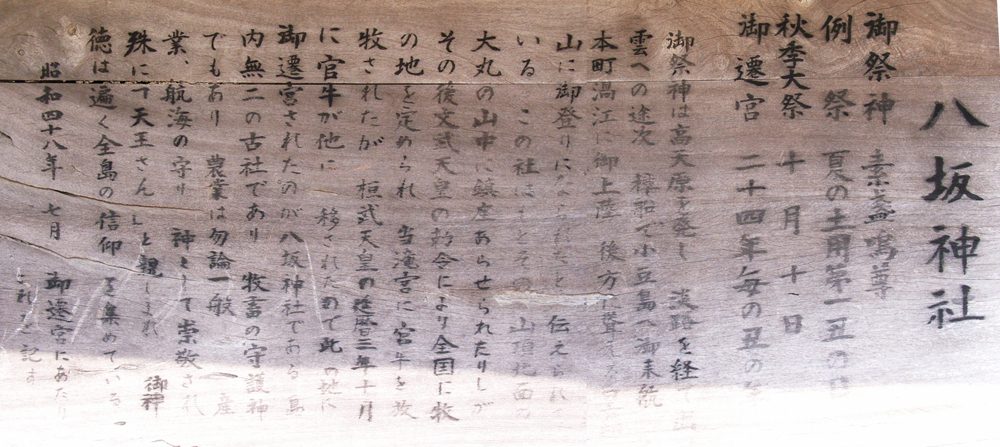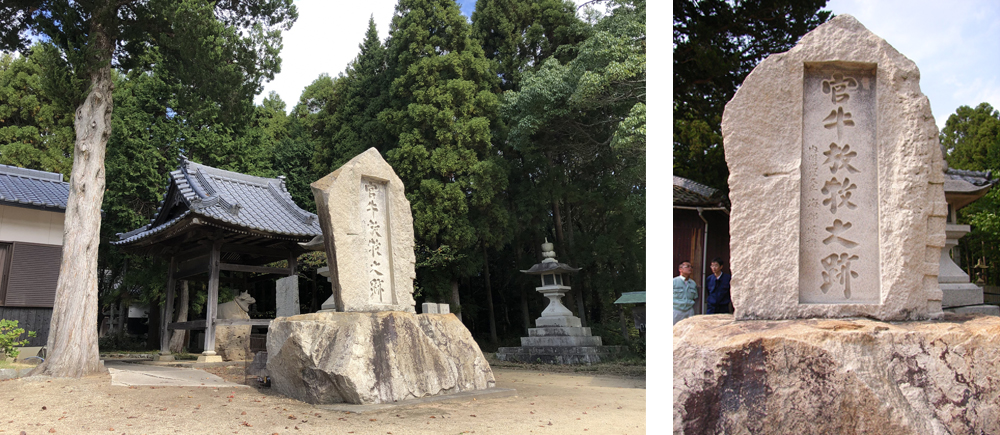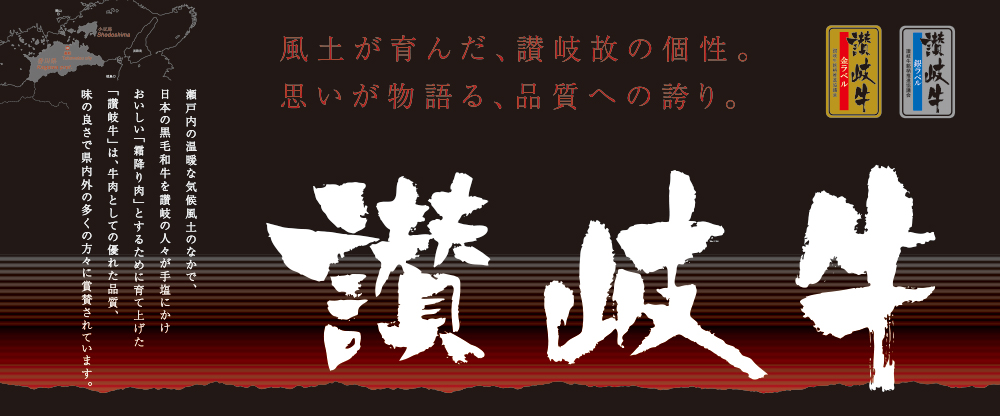



 讃岐牛は、明治15年頃、全国にさきがけて香川県の小豆島に黒毛和種の肥育が始まったのが最初です。小豆島には古くから、牛の神様として崇拝されている八坂神社があります。ここの境内の笹を牛に食べさすと病気をしないとの言い伝えがあり、近くの人々は牛を連れてきて笹を食べさせ、遠くの人々は笹を持ち帰るなどして、牛の健康を祈願しておりました。また、ここは古くから養牛の盛んな地域で、境内には、官牛放牧之跡の石碑があります。碑文には、遠く神代においてスサノオノミコトが小豆島で牧畜を起こし、奨励したと伝えられていること。約1,300年前の文武天皇の勅旨で官牛の放牧がなされたと、続日本紀にあることなどが紹介されています。
讃岐牛は、明治15年頃、全国にさきがけて香川県の小豆島に黒毛和種の肥育が始まったのが最初です。小豆島には古くから、牛の神様として崇拝されている八坂神社があります。ここの境内の笹を牛に食べさすと病気をしないとの言い伝えがあり、近くの人々は牛を連れてきて笹を食べさせ、遠くの人々は笹を持ち帰るなどして、牛の健康を祈願しておりました。また、ここは古くから養牛の盛んな地域で、境内には、官牛放牧之跡の石碑があります。碑文には、遠く神代においてスサノオノミコトが小豆島で牧畜を起こし、奨励したと伝えられていること。約1,300年前の文武天皇の勅旨で官牛の放牧がなされたと、続日本紀にあることなどが紹介されています。
 The history of Sanuki Wagyu began in 1882, when Shodoshima Island in Kagawa Prefecture became the first place in Japan to raise Kuroge Wagyu cattle (Japanese Black) for beef. Shodoshima is home to Yasakajinja Shrine, where a cow has been worshipped as a divine messenger since long ago. It is said that cows which feed on the bamboo grass growing within the shrine grounds will not become sick. Praying for the health of their cattle, people living in the area would graze their cows at the shrine, or bring the grass home with them if they lived far away. Additionally, this area has a long history of raising cattle for farm work. Within the shrine grounds you can find a stone monument which describes Kangyuhoboku no Ato (Site of Official Cattle Farming). On the monument it is written that in ancient times, a god named Susano-o no Mikoto raised cows on Shodoshima and encouraged cattle farming. It also describes how official cattle farming on Shodoshima, which was ordered by Emperor Monmu approximately 1,300 years ago, was recorded in the Shoku Nihongi, an imperially commissioned historical text.
The history of Sanuki Wagyu began in 1882, when Shodoshima Island in Kagawa Prefecture became the first place in Japan to raise Kuroge Wagyu cattle (Japanese Black) for beef. Shodoshima is home to Yasakajinja Shrine, where a cow has been worshipped as a divine messenger since long ago. It is said that cows which feed on the bamboo grass growing within the shrine grounds will not become sick. Praying for the health of their cattle, people living in the area would graze their cows at the shrine, or bring the grass home with them if they lived far away. Additionally, this area has a long history of raising cattle for farm work. Within the shrine grounds you can find a stone monument which describes Kangyuhoboku no Ato (Site of Official Cattle Farming). On the monument it is written that in ancient times, a god named Susano-o no Mikoto raised cows on Shodoshima and encouraged cattle farming. It also describes how official cattle farming on Shodoshima, which was ordered by Emperor Monmu approximately 1,300 years ago, was recorded in the Shoku Nihongi, an imperially commissioned historical text.

京阪神で讃岐牛の愛称で呼ばれるようになったのは大正の初めです。その後、香川県三豊郡、仲多度郡、綾歌郡と肥育が広まり全県に讃岐牛の肥育が普及しました。そして、讃岐の人々のたゆまない努力と恵まれた気候風土のなかで培われた伝統的肥育技術は、今にいたる讃岐牛生産の礎となっています。
At the beginning of the Taisho period (1912-1926), these cattle began to be referred to as “Sanuki Wagyu ” in Kyoto, Osaka and Kobe. Later, raising cattle for beef spread to the Mitoyo, Nakatado and Ayagawa districts of Kagawa, becoming popular throughout the prefecture. These traditional methods of cattle farming, cultivated by the tireless efforts of farmers and fostered by the mild climate of the Sanuki region, have become the cornerstone of the Sanuki Wagyu industry, which continues to this day.
